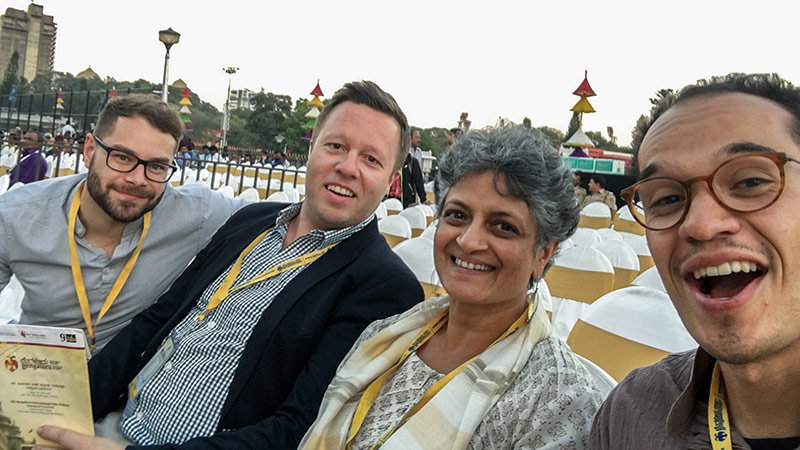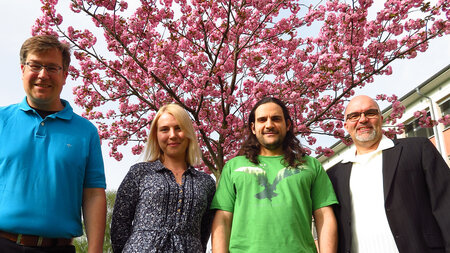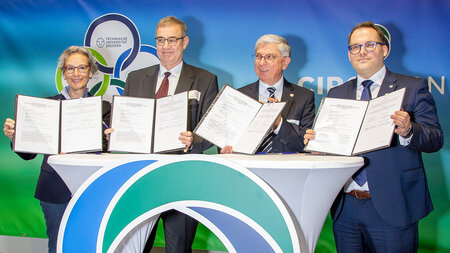Four and a half months of cultural work in India’s IT capital
Chemnitz University of Technology student Lars Meese shares his experiences as an intern at the culture department of the Goethe-Institut / Max Mueller Bhavan Bangalore (India)
-

Lars Meese along with institute director Dr. Claus Heimes, Maureen Gonsalves, head of the cultural department and Elias Krössin, ‘kulturweit’ intern, at the inauguration of the Bengaluru Film Festival 2017 (from left to right) Photo: private
The passion to broaden my horizon abroad resurfaced, when a friend of mine narrated about her extended internship in Bangladesh and Indonesia. However this time, I wanted to not only play the role of a tourist. Hence, I decided to research various opportunities for internships in countries out of Europe and finally came across the Goethe-Institut. Positive reviews from friends supported my decision to apply there, focusing mainly on branches located in South and Southeast Asian countries due to my own personal interest. Shortly after applying, I received a positive response from Bangalore, a metropolitan city in the South of India, where I spent my time from January till the middle of May of this year.
Located in the state of Karnataka, the city is presumably home to big domestic and foreign technological enterprises. Furthermore for the majority of tourists, Bangalore might only serve as a hub to reach cultural and nature hotspots of other cities in southern India. However, my time at the Goethe-Institut has confirmed me that the metropolis has a lot more to offer than just IT companies. Although the tourist landmarks cannot be compared to those in Delhi, Mumbai or Kolkata, the cultural scene of Bangalore is definitely a flourishing one. For example, I caught a glimpse of old and traditional theatres as well as newly established ones. In addition, I witnessed many artists and entrepreneurs committing themselves to performance arts, dance and movement arts, but also addressing issues within the Indian society. Owing to my time at the institute, I was constantly in touch with these cultural performers. This was also mainly because the Goethe-Institut collaborates with galleries, artists, acting and dancing academies for various long and short term projects. The cultural exchange between Germany and India is interdependent. One of the best examples describing this is the most sought after residency program called bangaloREsidency. It was established to give artists living and working in Germany the opportunity to come to Bangalore and work with people of the local art scene.
When I arrived in the city at the turn of the year, the residency was already in its final chords. It was predicted to be a rather relaxed couple of weeks for my colleagues and me in the cultural department. Fortunately, this was not the case. Already in January, we had to organize good-bye events for two bangaloREsidents. Therefore, I had to take over the support of the artists from my predecessors and also the promotion of the event on the website via our various social media networks, which was a big advantage for me as a media communication student. Those two events were followed by two big festivals in February, the Attakalari India Biennial and the Bengaluru Film Festival, where we were again part of the organisation and promotion. Besides this, drafting letters and also taking care of arrangements to make the exchange happen for German as well as Indian artists was also an essential part of my job. Though the days at the institute did not only comprise of an eight-hour work day, but also included several evening events such as exhibitions and gallery openings etc. which were good opportunities to meet important people from the art and culture scene.
Impressions from a busy metropolis
It was a rare occurrence for me to have free weekends, mostly because they were filled with interesting events hosted either by the Goethe-Institut or being supported by them. Though exploring the city was a tricky task and demanded some advance planning. Nevertheless, there were a lot of opportunities to witness the night life of the city with its strong western influence. My colleagues and I at times ended up going to pubs for a drink or to the movies. A welcome diversion from stressful days at work was also seeing the local football club Bangalore FC with its growing fan base. Because of the location of the Goethe-Institut in the area called Indiranagar, the visibility of poverty was seldom, as it is one of the wealthier areas of Bangalore. Although one could still witness people sleeping on foot paths as well as stray dogs and beggars in the other parts of the city. The feeling of being thrown into a whole other world came to mind a lot of times while wandering through the ten-million-citizen-metropolis. For example, the area called Chickpet with its big market, where one can find lots of busy people and never ending traffic with honking vehicles everywhere. Amidst this chaos, you had salesmen selling a wide range of goods or food, some often sitting on the ground, while others selling it out of their stalls or from wooden carts.
Even though Bangalore, according to certain studies, is one of the most livable cities in India, one can still see the poverty and also the pollution as a result of waste and the limitless traffic. Therefore on my free weekends, I had often used every opportunity to escape the city. Many western tourists while travelling to India probably only take into consideration Goa and the north of India, but the south also offers the same degree of culture and landmarks. On the top of my list was the former French colony Pondicherry located on the south east coast as well as the city Hampi famous for its cluster of ancient temples. The city of Mysore with its magnificent palace ”Amba vilas“ is best suited for a one-day excursion. The hill stations located in the Nilgiris Mountains also offer a nice escape from busy Bangalore and its hot temperatures. Back in the days, officials of the British Empire had enjoyed the cool climate and the beautiful nature of these hill stations such as Conoor or Ooty. But even though I was able to visit a lot of places, it was just a tiny fraction of this big and fascinating country. It will surely not be my last travel to India.
Looking back at these four and a half months living in Bangalore and working at the Goethe-Institut, I do not regret a single moment of it. It provided me not only with an advantage for my cv, but also with unforgettable experiences and relationships.
(Author: Lars Meese)
Mario Steinebach
21.06.2017





